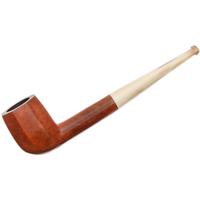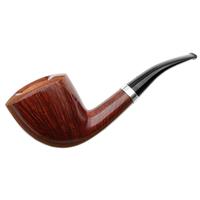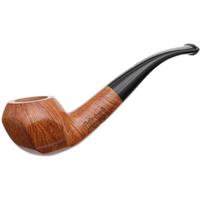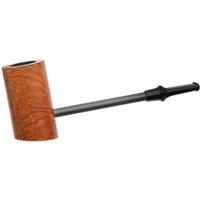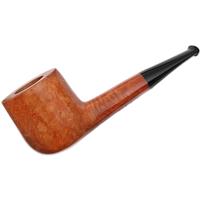Do any of you own an amber-stemmed Dunhill pipe? I would like to know what sort of fitment they were using around 1920. The normal method that other pipe makers were using was a screw tenon made of bone. I have heard of, but not seen, a method where a vulcanite tenon is screwed into the amber and then attaches to the stummel in the conventional way. The stem on my pipe is does not rotate with gentle pressure. I do not wish to risk breaking the delicate amber merely to satisfy a curiosity.
After weeks of watching my package languish in US Customs in Chicago, I was finally able to hold and inspect the 1920 cased, amber-stemmed, roughly group 3, shape 24, "A" finish (first grade Bruyere) billiard. I'll post some proper photos later, but here is a quick preview.
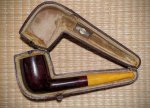
This pipe was previously discussed immediately after I had won the auction. The amber stem lacks a white dot, despite the The White Spot logo in the case. A friend is under the impression that the spot was sometimes placed on the tenon of early amber-stemmed Dunhill pipes. He shared a photo of a two-pipe cased set of similar pipes which similarly lacked a white dot. I have asked George Dibos, Ronni B, Chuck Gray (the retired expert amber repairman), Adam Davidson, and Rich Esserman about this and none had any actual knowledge to share, but Ronni B shared that if the registration is excellent, it is almost certainly original.
Well, the registration is excellent. There is virtually no gap between the shank face and the face of the stem. It appears to be very slightly over-rotated, but based upon the fit and the general fine condition of the pipe and case, I'm feeling fairly confident that the stem is original.
Here's the thing. I would love to see that fitment, because if there is a white dot there, it would be rather unique and interesting. Knowing the type of fitment would help me to know which direction to turn and how much resistance to expect. Even armed with that knowledge, I'll still probably be too cautious to apply sufficient pressure. So, I'll probably just smoke it and hope that a combination of use and environmental conditions somehow free it up. In any case, I'd like to know which direction to twist. Thanks!
After weeks of watching my package languish in US Customs in Chicago, I was finally able to hold and inspect the 1920 cased, amber-stemmed, roughly group 3, shape 24, "A" finish (first grade Bruyere) billiard. I'll post some proper photos later, but here is a quick preview.

This pipe was previously discussed immediately after I had won the auction. The amber stem lacks a white dot, despite the The White Spot logo in the case. A friend is under the impression that the spot was sometimes placed on the tenon of early amber-stemmed Dunhill pipes. He shared a photo of a two-pipe cased set of similar pipes which similarly lacked a white dot. I have asked George Dibos, Ronni B, Chuck Gray (the retired expert amber repairman), Adam Davidson, and Rich Esserman about this and none had any actual knowledge to share, but Ronni B shared that if the registration is excellent, it is almost certainly original.
Well, the registration is excellent. There is virtually no gap between the shank face and the face of the stem. It appears to be very slightly over-rotated, but based upon the fit and the general fine condition of the pipe and case, I'm feeling fairly confident that the stem is original.
Here's the thing. I would love to see that fitment, because if there is a white dot there, it would be rather unique and interesting. Knowing the type of fitment would help me to know which direction to turn and how much resistance to expect. Even armed with that knowledge, I'll still probably be too cautious to apply sufficient pressure. So, I'll probably just smoke it and hope that a combination of use and environmental conditions somehow free it up. In any case, I'd like to know which direction to twist. Thanks!



